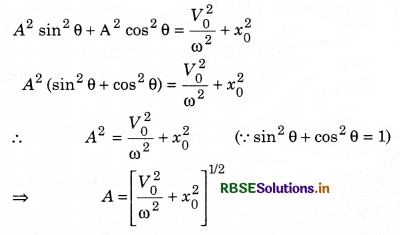RBSE Solutions for Class 11 Physics Chapter 14 Oscillations
Rajasthan Board RBSE Solutions for Class 11 Physics Chapter 14 Oscillations Textbook Exercise Questions and Answers.
RBSE Class 11 Physics Solutions Chapter 14 Oscillations
RBSE Class 11 Physics Oscillations Textbook Questions and Answers
Question 14.1.
Which of the following examples represent periodic motion?
(a) A swimmer completing one (teturn) trip from one bank of a river to the other and back.
(b) A freely suspended bar magnet displaced from its N-S direction and released.
(c) A hydrogen molecule rotating about its centre of mass.
(d) An arrow released from a bow.
Answer:
(a) Non-periodic motion as there is no definite period.
(b) Period motion becasue a freely suspended magnet if once displaced from N → S direction, it oscillates about this position.
(c) Periodic motion.
(d) Non-periodic motion.

Question 14.2.
Which of the following examples represent (nearly) simple harmonic motion and which represent periodic but not simple harmonic motion?
(a) the rotation of earth about its axis.
(b) motion of an oscillhting mercury column in a U-tube.
(c) motion of a ball bearing inside a smooth curved bowl, when released from a point slightly above the lower most point.
(d) general vibrations of a polyatomic molecule about its equilibrium position.
Answer:
(a) Periodic but not S.H.M
(b) S.H.M
(c) S.H.M
(d) Periodic but not S.H.M.
Question 14.3.
Fig. given depicts four x-t plots for linear motion of a particle. Which of the plots represent periodic motion? What is the period of motion (in case of periodic motion)?

Answer:
(a) Non-periodic motion
(b) Periodic motion
Period = 2s
(c) Non-periodic motion
(d) Periodic motion
Period = 2s
Question 14.4.
Which of the following functions of time represent (a) simple harmonic, (b) periodic but not simple harmonic, and (c) non-periodic motion? Give period for each case of periodic motion (ω is any positive constant)-
(a) sin ωt - cos ωt
(b) sin3 ωt
(c) 3 cos (\(\frac{\pi}{4}\) - 2ωt)
(d) cos ωt + cos 3ωt + cos 5ωt
(e) exp (-ω2t2)
(f) 1 + ωt + ω2t2
Answer:
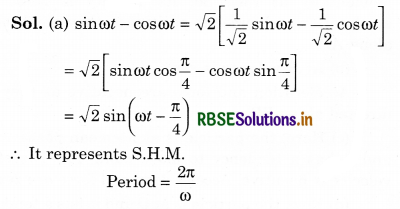
(b) sin2 ωt = \(\frac{1}{4}\) [3 sin ωt - sin 3ωt]
Each term present S.H.M
But sin3 ωt is perodic and not SHM
Its time period = \(\frac{2 \pi}{\omega}\)
(c) 3 cos (\(\frac{\pi}{4}\) - 2ωt) = 3 cos (2ωt - \(\frac{\pi}{4}\))
It represents S.H.M
Period = \(\frac{2 \pi}{2 \omega}=\frac{\pi}{\omega}\)
(d) cos ωt + cos 3ωt + cos 5ωt
It represents periodic but not SHM
Period = \(\frac{2 \pi}{\omega}\)
(e) e-ω2t2
It is non-perodic function because it never repeats itself.
(f) 1 + ωt + ω2t2
It is non-perodic function.
Question 14.5.
A particle is in linear S.H.M. between two points A and B, 10 cm apart. Take the direction from A to B as the positive direction and give the signs of velocity, acceleration and force on the particle when it is:
(a) at the end A
(b) at the end B
(c) at the mid point of AB going towards A
(d) at 2 cm away from B going towards A
(e) at 3 cm away from A going towards B
(f) at 4 cm away from B going towards A

Answer:
(a) At A, the particle executing S.H.M. is momentaily at rest. So, its velocity is zero. The acceleration and force are positive as they are directed along AP.
(b) At B, velocity is zero. Acceleration and force are negative as they are directed along BP.
(c) Here, the particle is at its mean position (P), and it has a tendency to move along PA Therefore, velocity is negative. Acceleration and force are zero.
(d) Now, the particle is at Q and it has a tendency to move along QP. Therefore, velocity, acceleration and force are negative.
(e) Now, the particle is at R and it has a tendency to move along RP. Hence, velocity, acceleration and force are positive.
(f) The particle is at S and has a tendency to move along SA. So, velocity is negative. Acceleration is directed towards mean position. So, acceleration and force are positive.

Question 14.6.
Which of the following relationships between the acceleration (a) and the displacement (x) of a particle involve simple harmonic motion.
(a) a = 0.7 x
(b) a = -200x2
(c) a = -10x
(d) a = 100x3
Answer:
In S.H.M,
a = -kx
It is true only for (c)
Question 14.7.
The motion of a particle is SHM is decribed by the displacement function, x(t) = A cos (ωt + Φ). If the intial (t = 0) position of the particle is 1 cm and its initial velocity is ω cms-1, what are its amplitude and initial phase angle? The angular frequency of the particle is πs-1. If instead of the cosine function, we choose the sine function to describe the S.H.M.:
x = B sin (ωt + α), what are the Amplitude and initial phase of the particle with the above inital conditions.
Answer:
At t = 0, x = 1 cm
V = ω cms-1
ω = πs-1
x = A cos(ωt + Φ)
∴ 1 = A cos (π x 0 + Φ) = A cos Φ
∴ A cos Φ = 1 ...............(1)
Velocity, V = \(\frac{d x}{d t}\) = -A ω sin(ωt + Φ)
V = ω = -A ω sin (π x 0 + Φ)
1 = -A sin Φ
∴ A sin Φ = -1 ..................(2)
Squaring and adding eqn.(1) and (2), we get
A2 cos2 Φ + A2 sin2 Φ = 1 + 1
⇒ A2(cos2 Φ + sin2 Φ) = 2
⇒ A2 = 2
or, A = \(\sqrt{2}\) cm
Dividing eqn. (2) by (1), we get
tan Φ = -1
or Φ = \(\frac{3 \pi}{4}\) or \(\frac{7 \pi}{4}\)
For x = B sin(ωt + α) ....................(3)
At t = 0, x = 1
∴ 1 - B sin (ω x 0 + α)
∴ B sinα = 1 ....................(4)
Differentiating eqn. (3) w.r.t. x, to get velocity
V = \(\frac{d x}{d t}\) = Bω cos (ωt + α)
Applying initial condition,
at t = 0, V = ω
ω = Bω cos (π x 0 + α)
1 = B cosα
or B cosα = 1 .....................(5)
Squaring and adding eqn. (4) and (5), we get
B2 sin2 α + B2 cos2 α = 1 + 1
⇒ B2 (sin2 α + cos2 α) = 2
B = \(\sqrt{2}\) cm
Dividing eqn. (4) by (5), we have
\(\frac{B \sin \alpha}{B \sin \alpha}=\frac{1}{1}\)
⇒ tanα = 1
∴ θ = \(\frac{\pi}{4}\) or \(\frac{5 \pi}{4}\)
Question 14.8.
A spring balance has reads from 0 to 50 kg. The length of the scale is 20 cm. A body suspended from this spring, when displaced and released, oscillates with period of 0.60 s. What is the weight of the body?
Answer:
Mass, m = 50 kg
Maximum extension, y = 20 - 0 = 20 cm = 0.2 m
T = 0.6 s
Maximum force, F = mg = 50 x 9.8
∴ k = \(\frac{F}{y}=\frac{50 \times 9.8}{0.2}\)
= 2450 Nm-1
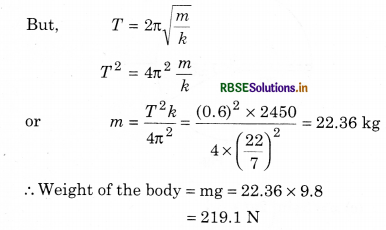
Question 14.9.
A spring with a spring constant 1200 Nm-1 is mounted on a horizontal table as shown in given figure. A mass of 3.0 kg is attached to the free end of the spring. The mass is then pulled side ways to a distance of 2.0 cm and released. Determine.
(a) the frequency of oscillations of the mass,
(b) the maximum acceleration of the mass,

(c) the maximum speeed of the mass.
Answer:
Given,
k = 1200Nm-1
m = 3 kg
a = 2 cm 0.02 m
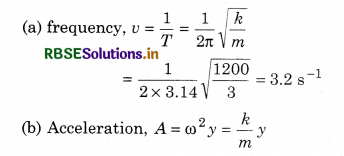
(b) Acceleration, A = ω2y = \(\frac{k}{m}\)y
Acceleration is maximum when y = maximum (a)
∴ Maximum acceleration, Amax = \(\frac{k_a}{m}\)
= \(\frac{1200 \times 0.02}{3}\) = 8 ms-2
(c) Maximum speed
Vmax = aω = a\(\sqrt{\frac{k}{m}}\)
= 0.02 x \(\sqrt{\frac{1200}{3}}\) = 0.4 ms-1
Question 14.10.
In Q.14.9, let us take position of mass when the spring is unstretched as x = 0, and the direction from left to right as the positive direction of x-axis. Given has a function of time t for the oscillating mass if at the moment we start the stop watch (t = 0), the mass is (a) at the mean position (b) at the maximum stretched position, and (c) at the maximum compressed position. In what way do these functions for S.H.M. differ from each other, in frequency, in amplitude or the initial phase?
Answer:
Given: a = 2 cm
ω = \(\sqrt{\frac{k}{m}}=\sqrt{\frac{1200}{3}}\) = 20 s-1
(a) x = a sin 20t
∴ x = 2 sin 20t
(b) Initial phase of π/2
x = a sin (ωt + \(\frac{\pi}{2}\)) = a cos ωt = 2 cos 20t
(c) Initial phase of \(\frac{ 3\pi}{2}\),
x = a sin (ωt + \(\frac{3\pi}{2}\)) = -a cos ωt = -2 cos 20t

Question 14.11.
Figures given here corresponed to two circular motions. The radius of the circle, the period of revolution, the initial position, and the sense of revolution (i.e., clockwise or anti-clockwise) are indicated on each figure. Obtain the corresponding simple harmonic motions of the x-projection of the radius vector of the revolving particle P, in each case.
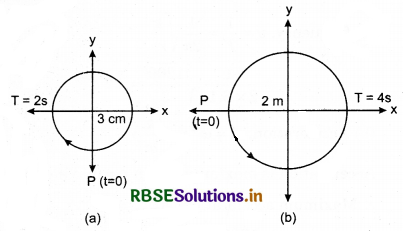
Answer:
From fig.(a), T = 2s, a = 3 cm
At t = 0, Φ = π/2
x-projection of OP at time t,
x = a cos \((\frac{2 \pi t}{T}\) + Φ)
= 3 cos (\(\frac{2 \pi t}{2}\) + \(\frac{\pi t}{2}\))
∴ x = -3 sin πt
From fig. (b),
T = 4s, a = 2 cm
At t = 0, Φ = π
x-projection of OP at time t,
x = a cos (\(\frac{2 \pi t}{T}\) + Φ)
= 2 cos (\(\frac{2 \pi t}{4}\) + π) = -2 cos (\(\frac{\pi t}{2}\)t)
Question 14.12.
Plot the corresponding reference circle for each of the following simple harmonic motions. Indicate the initial (f = 0) position of the particle, the radius of the circle, and the angular speed of the rotating particle. For simplicity, the sence of rotation may be fixed to be anticlockwise in every case : (x is in cm and t is in s).
(a) x = -2 sin (3t + π/3)
(b) x = cos (π/6 - t)
(c) x = 3 sin (2πt + π/4)
(d) x = 2 cos πt
Answer:
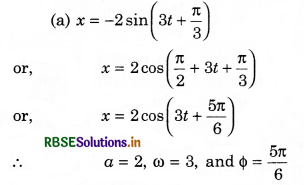
Therefore, the reference circle will be as shown in figure:
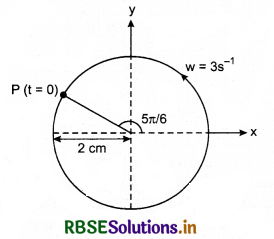
(b) x = cos (\(\frac{\pi}{6}\) - t) = cos (t - \(\frac{\pi}{6}\))
a = 1, ω = 1 and Φ = -\(\frac{\pi}{6}\)
The reference circle will be as shown below:
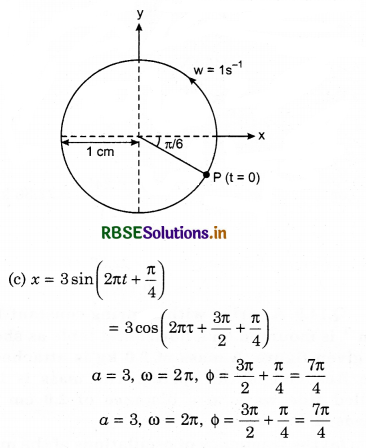
The reference circle will be as shown below:
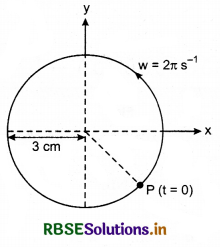
(d) x = 2 cos πt
a = 2, ω = π, Φ = 0
The reference circle will be as shown below:

Question 14.13.
Figure (a) shows a spring of force constant k clamped rigidly at one end and a mass m attached to its free end. A force F applied at the free end stretches the spring. Figure (b) shows the same spring with both ends free and attached to a mass m at either end. Each end of the spring in fig. (b) is stretched by the same force F.
(a) What is the maximum extension of the spring in the two cases?
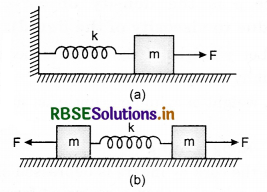
(b) If the mass in fig. (a) and the two masses in fig. (b) are released, what is the period of oscillation in each case?
Answer:
(a) The maximum extension of the spring in the two cases will be \(\frac{F}{k}\)
Here k is the spring constant
(b) In fig. (a),
F = -kx
T = 2π\(\sqrt{\frac{\text { Inertia factor }}{\text { spring factor }}}\)
∴ T = 2π\(\sqrt{\frac{m}{k}}\)
In fig. (b),
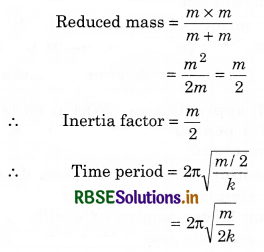
Question 14.14.
The piston in the cylinder head of a locomotive has a stroke (twice the amplitude) of 1.0 m. If the piston moves with simple harmonic motion with an angular frequency of 200 rev/min., what is its maximum speed?
Answer:
a = \(\frac{1}{2}\) m
ω = 200 rev/min
Vmax = aω = \(\frac{1}{2}\) x 200 = 100 m/min

Question 14.15.
The acceleration due to gravity on the surface of the moon is 1.7 ms-2. What is the time period of a simple pendulum on the surface of moon if its time period on the surface of earth is 3.5 s? (g on the surface of earth = 9.8 ms-2)
Answer:

Question 14.16.
Answer the following questions:
(a) Time period of a particle in S.H.M. depends on the force constant k and mass m of the particle: T = 2π\(\sqrt{\frac{m}{k}}\). A simple pendulum executes S.H.M. approximately. Why then is the time period of a pendulum independent of the mass of the pendulum?
(b) The motion of a simple pendulum is approximately simple harmonic for small angle oscillations. For larger angles of oscillation, a more involved analysis shows that T is greater than 2π\(\sqrt{\frac{l}{g}}\). Think of a qualitative argument to appreciate this result.
(c) A man with a wristwatch on his hand falls from the top of a tower. Does the watch give correct time during the free fall?
(d) What is the frequency of oscillation of a simple pendulum mounted in a cabin that is freely falling under gravity?
Answer:
(a) For a simple pendulum, the force constant k is proportional to mass m. So, m cancels out in denominator as well as in numerator.
So, the time period of a pendulum is independent of the mass of the pendulum.
(b) The effective restoring force on the bob of pendulum is F = -mg sinθ
When θ is small, then sinθ ≈ θ
∴ Time period of simple pendulum is
T = 2π\(\sqrt{\frac{l}{g}}\)
when θ is large, then sinθ < θ,
Now, if mg sin θ is replaced by mgθ then the value of g decreases for greater value of 0, and hence there is an increase in the value of T.
(c) Yes, the watch gives correct time during the free fall. It is so because the working of the wrist-watch depends on spring action and not on g.
(d) The gravity disappears for a man under free fall and heence, frequency is zero.
Question 14.17.
A simple pendulum of lenght l and having a bob of mass M is suspended in a car. The car is moving on a circular track of radius R with a uniform speed v. If the pendulum makes small oscillations in a radial direction about its equilibrium position. What will be its time period?
Answer:
Centripetal acceleration,
ac = \(\frac{v^2}{R}\) (it acts horizontally)
Acceleration due to gravity = g (it acts vertically downwards)
effective acceleration due to gravity,
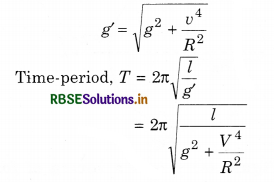
Question 14.18.
A cylindrical piece of cork of density of base area A and height h floats in a liquid of density ρ1. The cork is depressed slightly and then relesed. Show that the cork oscillates up and down simple harmonically with a period
T = 2π\(\sqrt{\frac{\boldsymbol{h} \rho}{\rho_1 \boldsymbol{g}}}\)
where ρ is the density of cork. (Ignore damping due to viscosity of the liquid).
Answer:
Let y height of the cylinder be inside the liquid, initially at equilibrium.
Then, weight of cylinder = upthrust due to liquid displaced
∴ Ahρg = Ay ρ1g
When the cork cylinders is depressed slightly by ∆y and then released, then a restoring force equal to additinoal upthrust acts on it.
The restoring force, F = A(y + ∆y)ρ1g - Ayρ1g
= Aρ1g∆y
∴ Acceleration, a = \(\frac{F}{m}=\frac{A \rho_1 g \Delta y}{A h \rho}=\frac{\rho_1 g . \Delta y}{h \rho}\)
The acclerationis directed opposite to the direction of ∆y
As acceleration α-∆y, then, motion of ork cylinder is S.H.M., whose time-period is
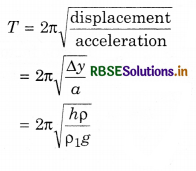
Question 14.19.
One end of a U-tube containing mercury is connected to a suction pump and the other end to atmosphere. A small pressure difference is maintained between the two columns. Show that, when the suction pump is removed, the column of mercury in the U-tube executes simple harmonic motion.
Answer:
Let ρ be the density of mercury, L be the total length of the mercury column in both the limbs, A be the internal cross-sectional area of U-tube, and m be the mass of mercury in U-tube.
Suppose, the mercury be depressed in left limb to F by a small distance y, then it rises by the same amount in the right limb.
∴ Difference in levels in the two limbs = 2y
∴ Volume of mercury contained in the column of length,
2y x A x 2y
∴ m = A x 2y x ρ
If W = weight of liquid contained in the column of length 2y.
Then, W = mg = A x 2y x ρ x g
This weight produces restoring force which tends to bring back the mercury to equilibrium position.
∴ F = -2Ayρg = -(2Aρg) y
Let a be the acceleration produced in the liquid column.
a = \(\frac{F}{m}=-\frac{(2 A \rho g) y}{L A \rho}=\frac{-2 A \rho g}{L A}\)
= \(\frac{-2 \rho g y}{2 h \rho}\) ............................(1) (As L = 2h)
Here h → height of mercury in each limb
Time period (T), T = 2π\(\sqrt{\frac{y}{a}}\)
= 2π\(\sqrt{\frac{2 h \rho}{2 \rho g}}\) = 2π\(\sqrt{\frac{h}{g}}\)
Additional Exercises
Question 14.20.
An air chamber of volume V has a neck area of cross-section A into which a ball of mass m just fits and can move up and down without any friction (see fig.). Show that when the ball is pressed down a little and released, it executes S.H.M. Obtain an expression for the time-period of oscillations assuming pressure-volume variations of air to be isothermal.
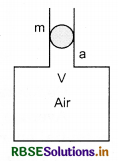
Answer:
Imagine an air chamber of volume V with a long neck of uniform cross-sectional area A, and frictionless ball of mass m fitted smoothly in the neck. The decrease in the volume of air inside the chamber,
∆V = Ay
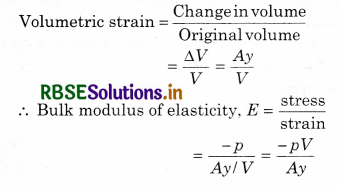
Negative sign indicates the increase in pressure will decrease the volume of air in the chamber.
P = \(\frac{-E A y}{V}\)
The restoring force acting on the ball due to this excess pressure,
F = P x A = \(\frac{-E A y}{V} \)A = \(\frac{-E A _2}{V}\) y ...........................(1)
Here, negative sign shows that the force is directed towards equilibrium position.
In S.H.M., the restoring force,
F = -ky .........................(2)
From eqns. (1) and (2), we get
Spring factor, k = \(\frac{E A^2}{V}\)
Inertia factor = Mass of the ball (m)
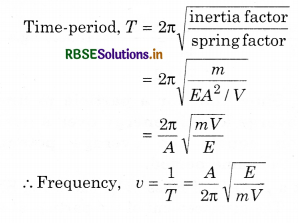

Question 14.21.
You are riding in an automobile of mass 3000 kg. Assuming that you are examining the oscillation characteristics of its suspension system. The suspension sags 15 cm when the entire automobile is placed on it. Also, the amplitude of oscillation decreases by 50% during one complete oscillation. Estimate the' values of (a) the spring constant k and (b) the damping constant b for the spring and shock absorber system of one wheel, assuming that each wheel supports 750 kg. (g = 10m/s2)
Answer:
Given: Mass = 3000 kg
x = 0.15 m
(a) If k is the spring constant of each spring, then, for the whole mass, it is equal to 4k.
∴ 4kx = mg
or k = \(\frac{M g}{4 x}=\frac{3000 \times 10}{4 \times 0.15}\) = 5 x 104 Nm-1
(b) Let m be the mass supported by each spring, then
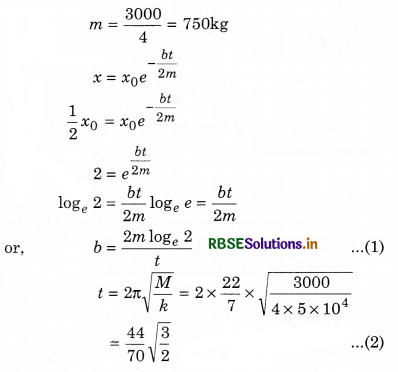
Putting the value of t from eqn. (2) in eqn (1), we get
b = \(\frac{2 m \log _e 2}{t}=\frac{2 \times 750 \times 0.6931}{\frac{44}{70} \sqrt{\frac{3}{2}}}\) = 1350.4 kg.s-1
Question 14.22.
Show that for a particle in linear S.H.M., the averge kinetic energy over a period of oscillation equals the average potential energy over the same period.
Answer:
Let a particle of mass m be executing SHM with period T. The displacement of the particle at any instant t be
y = a sin ωt
∴ Velocity, V = \(\frac{d y}{d t}\) = aω cos ωt
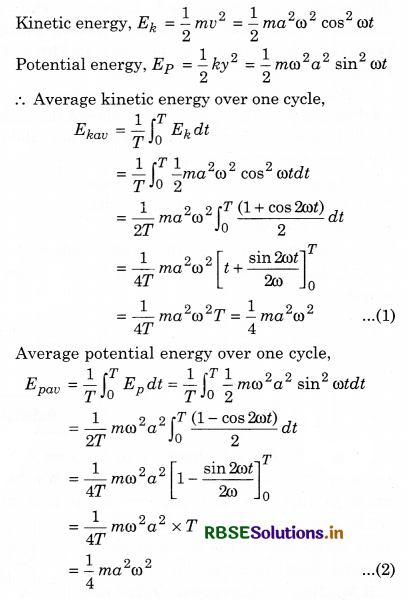
Comparing equation (1) and (2), we have
Average kinetic energy is equal to average potential energy.
Question 14.23.
A circular disc of mass 10 kg is suspended by a wire attached to its centre. The wire is twisted by rotating the disc and released. The period of torsional oscillations is found to be 1.5 s. The radius of the disc is 15 cm. Determine the torsional spring constant of the wire. (Torsional spring constant α is defined by the relation J = -αθ, where J is the restoring couple and θ the angle of twist).
Answer:
Mass, m = 10 kg
R = 15 cm = 0.15 m
T = 1.5 s
Moment of Inertia of disc, I = \(\frac{1}{2}\) mR2
= \(\frac{1}{2}\) x 10 x (0.15)2
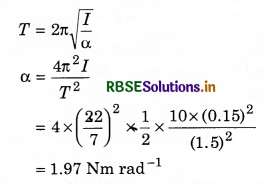
Question 14.24.
A body describes simple harmonic motion with an amplitude of 5 cm and a period of 0.2 s. Find the acceleration and velocity of the body when the displacement is (a) 5 cm, (b) 3 cm (c) 0 cm.
Answer:
Given: r = 5 cm = 0.05 m
T = 0.2 s
ω = \(\frac{2 \pi}{T}=\frac{2 \pi}{0.2}\) = 10 π rad-s-1.
If displacement if y, then acceleration A = - ω2y
velocity, V = ω\(\sqrt{r^2-y^2}\)
(a) y = 5cm = 0.5 m
A = -(10π)2 x 0.05 = -5π2 ms-2
v = 10π \(\sqrt{(0.05)^2-(0.05)^2}\) = 0
(b) y = 3 cm = 0.03 m
A = -(10π)2 x 0.03 = -3π2 ms-2
v = 10π\(\sqrt{(0.05)^2-(0.03)^2}\)
= 10π x 0.04 = 0.4 π ms-1
(c) y = 0, A = 0
v = 10π\(\sqrt{(0.05)^2-(0)^2}\)
= 10π x 0.05
= 0.05 π ms-1

Question 14.25.
A mass attached to a spring is free to oscillate, with angular velocity ω, in a horizontal plane without friction or damping. It is pulled to a distance x0 and pushed towards the centre with a velocity V0 at time t = 0. Determine the amplitude of the resulting oscillations in terms of the parameters ω, x0 and V0.
Answer:
At t = 0, x = x0, and \(\frac{d x}{d t}\) = -V0
x = A cos (ωt + θ)
∴ x0 = A cos θ .....................(1)
Velocity, \(\frac{d x}{d t}\) = -Aω sin (ωt + θ)
-v0 = -Aω sinθ
or v0 = Aω sinθ
⇒ \(\frac{v_0}{\omega}\) = A sinθ ........................(2)
Squaring and adding (1) and (2), we get
